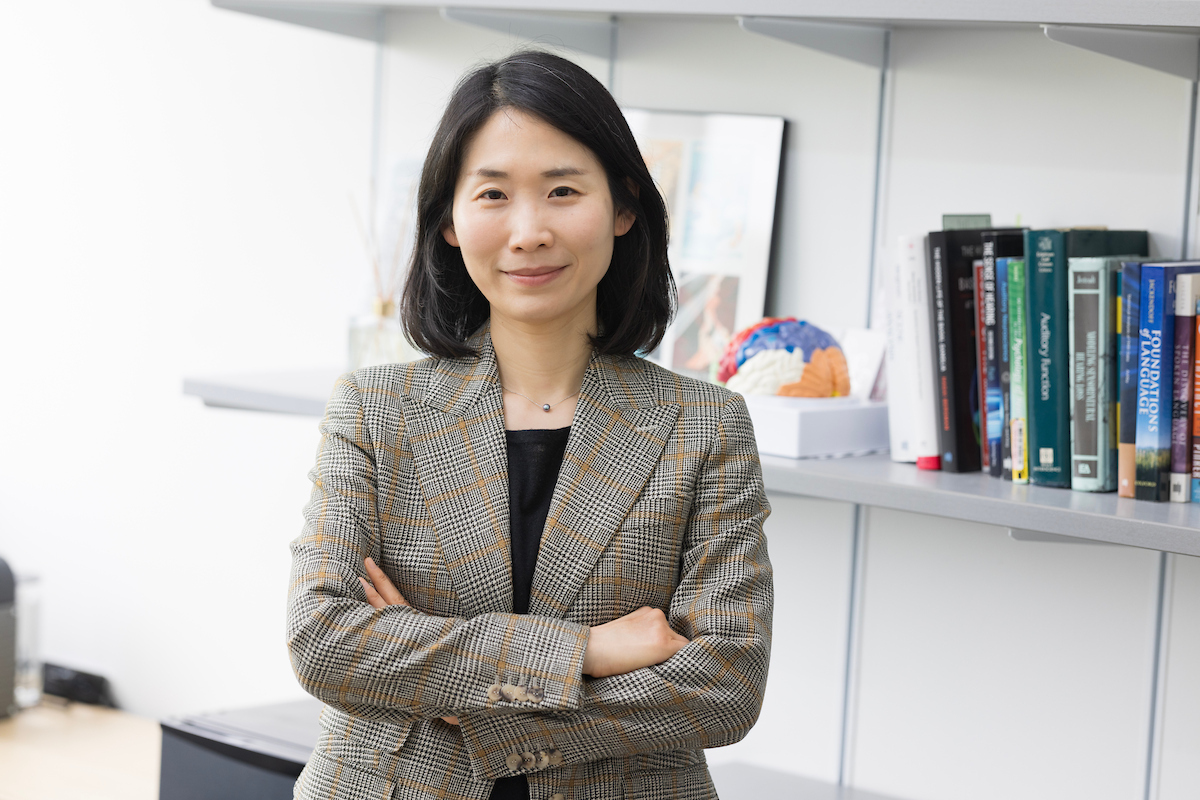Psychology professor wins NSF CAREER award
Major grant funds language learning research

Kids seem to pick up new languages faster than adults, which might feel especially grating after wrestling through another Duolingo lesson. But is there a different way to promote language learning in adults?
This is one of the central questions of Sung-Joo Lim’s work funded by a new National Science Foundation (NSF) CAREER grant, which could eventually tap into a new pathway toward greater brain plasticity.
“That’s the funny thing about adults. We do know well, and we do have a lot of skills, and you can actually learn new skills or new knowledge as an adult pretty well,” said Lim, an assistant professor of psychology. “But when it comes to the learning of speech and language, not so much.”
CAREER awards are prestigious distinctions given to researchers with the potential to become future leaders in their fields. Lim will receive $815,269 over the next five years to dive deeper into the brain pathways that lead to language acquisition.
The first step to mastering any foreign language is to nail the sounds that comprise it. You might have a teacher telling you explicitly which sound is which, and whether you’re getting it right or wrong. But native Japanese speakers, for example, have a hard time telling between the English “L” and “R” sounds even after spending a number of years learning the language. Likewise, native English speakers just can’t seem to grasp certain pronunciations in Korean or tone categories in Mandarin.
If direct instruction isn’t working, then perhaps it’s time to look at implicit learning — coincidentally, this is how children pick up new languages.
“Can we create some learning environment like how infants learn? They’re never given an explicit instruction — they wouldn’t understand it anyway because their language is not developed yet. But somehow, they picked it up,” Lim said. “We want to create a more naturalistic kind of environment where adults can pick up the sound categories in a foreign language.”
From music to sound
Lim’s interest in the mechanisms of sound stems from growing up in a musical family. Though she played both piano and violin, Lim is the only person in her family who did not become a professional musician.
Yet, the questions of how humans perceive sounds continued to fascinate her.
“I thought maybe doing a more psychology or neuroscience type of approach might help me to delve more into my core interests that I always had,” she said.
Lim’s CAREER grant builds on work she pursued during her doctorate. To test how adult learners internalize specific sounds, she created a Space Invaders-esque video game. Aliens inside the game came with specific sounds, and the players had to capture or shoot them.
However, they had no actual instruction about the sounds. Instead, they were only told to play the game. Yet, players eventually figured out the unique sound categories, even without being taught.
“That seems to suggest there might be a different network in the brain that is responsible for inducing this kind of learning,” Lim said. “Learning, without really knowing that you’re learning.”
Specifically, this phenomenon might stem from the fact that getting rewards reinforces certain behaviors, the brain region possibly responsible for that type of learning being the basal ganglia.
Moreover, the basal ganglia, according to Lim, are not only connected to our auditory processing center, but also our motor region (think of a time you’ve tapped your foot to a catchy beat). Since the basal ganglia are connected to both these loops, Lim aims to research if these brain networks might work together to improve language acquisition as a whole.
“Using what we know from how the brain tracks regular rhythm, we want to use that effect to ask, ‘Hey, for some speech sound categories that are really difficult to learn, that involves the same network, can we boost the learning?” she said.
All these different puzzle pieces are what Lim is trying to fit into a broader picture of the parts of the brain we tap into when unknowingly categorizing new sounds.
“These lines of research communities have been very separate. There wasn’t really a cross-talk between these communities in terms of the research lines. So I’m trying to almost bring that research together, to understand the processing of this brain network,” Lim said. “Hopefully, by learning this, we might be able to better understand the ways we can promote brain plasticity better.”
A never-before-heard sound
With her CAREER award, Lim will build on the same principles of her video game task. But she can’t use any sound that’s already known in any kind of language. To ensure everyone’s starting on an even playing field, Lim will instead test subjects’ categorization skills with artificial noises.
Using both electroencephalography (EEG) and MRIs to map out brain activity, Lim and her team will also complement that with non-invasive brain stimulation to try and boost the basal ganglia.
“Can we induce their brain activity to follow the sounds better? By making that happen, would they be able to now learn the sound categories better?” she said. “We will study if there is a causal role in this function.”
Alongside collaborators Kopernik Observatory & Science Center and the Binghamton ESL program, she will then take her research out of the lab and integrate her findings among real-life learners — a far more complex process beyond carefully controlled experiments.
As she works to confirm the role of implicit learning in language education, Lim hopes to eventually analyze how that same system might apply not just to simple speech patterns, but also even more unwieldy linguistic rules like grammar.
“I feel very grateful for having this opportunity to learn more about how learning takes place in our brain,” she said. “I’m especially excited about the prospect of discovering ways to make learning easier and more efficient for adults.”
